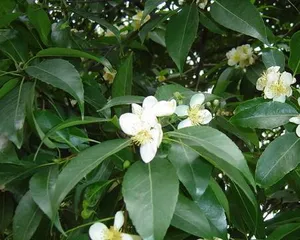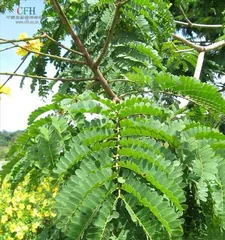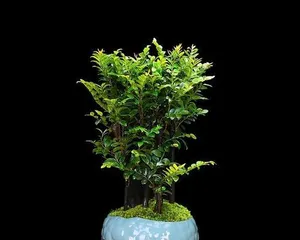The Five Elements theory is one of the fundamental theories of ancient Chinese philosophy, and it has a significant impact on Chinese culture, medicine, divination, and other aspects. Among them, the Wood element is one of the Five Elements, representing growth, development, and youth. In nature, there are also many plants classified as belonging to the Wood element. This article will explore the types and characteristics of these plants, let's uncover the mysteries of the Wood element together!

Peach Tree
The peach tree is a representative plant of the Wood element. As early as in ancient poetry, there is the famous line "The peach blossom pool's water is a thousand feet deep, not as deep as Wang Lun's farewell to me." Its flowers are delicate and lovely, and its tender green leaves are often used as medicinal herbs.
Pine Tree
The pine tree is a representative plant of the Wood element and one of the most common tree species in northern regions. The pine tree has a very profound cultural connotation and often appears in ancient poetry and paintings. The wood of the pine tree is hard and can be used to make furniture and building materials.

Bamboo
Bamboo is one of the representative plants of the Wood element. Its nature is very flexible; it can not only be used to make crafts and furniture but also various practical daily necessities. As a green plant, bamboo can effectively absorb carbon dioxide and has excellent environmental protection effects.
Cherry Blossom Tree
The cherry blossom tree is one of the representative plants of the Wood element. It is the national flower of Japan and one of the most beautiful tree species in East Asia. The cherry blossoms are gorgeous and captivating, possessing a very high ornamental value, and have become a beautiful dream in many people's hearts.
Camphor Tree
The camphor tree is one of the representative plants of the Wood element and one of the most common tree species in southern regions. The trunk of the camphor tree is sturdy, and its leaves are lush and beautiful. Its wood is hard and solid, and can also be used to make furniture and building materials.

Lotus Flower
The lotus flower is one of the representative plants of the Wood element. Its flowers are as delicate as jade and have a pleasant fragrance. It is often used as a ceremonial plant. The rhizome of the lotus flower is rich in medicinal ingredients and can be used to treat various diseases.
Ginkgo Tree
The ginkgo tree is one of the representative plants of the Wood element and a symbol in traditional Chinese culture. The leaves of the ginkgo tree are fan-shaped, yellow-green, and have a high ornamental value. Its fruit can be made into nutritious food and can also be used to make health products.
Willow Tree
The willow tree is one of the representative plants of the Wood element. Its branches are as soft as silk, and its leaves are tender green. Willow trees are often used to make flower baskets and bonsai, and can also be used to make certain furniture.
Red Maple Tree
The red maple tree is one of the representative plants of the Wood element and one of the most common tree species in North America. The leaves of the red maple tree show a very beautiful red color, and it is one of the most beautiful sights in autumn. The wood of the red maple tree is hard and can be used to make building materials and furniture.
Tea Plant
The tea plant is one of the representative plants of the Wood element and a very important plant in traditional Chinese culture. The leaves of the tea plant can be made into tea, which has rich health benefits. The branches and leaves of the tea plant can also be used as medicinal herbs.
Poplar Tree
The poplar tree is one of the representative plants of the Wood element and one of the most common tree species in northern regions. The wood of the poplar tree is light and soft, and can be used to make boats and rafts. The leaves of the poplar tree also have a high ornamental value.
Jujube Tree
The jujube tree is one of the representative plants of the Wood element and a very important plant in traditional Chinese culture. The fruit of the jujube tree can be made into foods like jujube paste and jujube cakes, and can also be used to make health products.
Crape Myrtle
Crape myrtle is one of the representative plants of the Wood element. It blooms with beautiful purplish-red flowers in summer. The bark of crape myrtle has high medicinal value and can be used to treat various diseases.
Phoenix Tree
The phoenix tree is one of the representative plants of the Wood element and one of the most common tree species in southern regions. The phoenix tree is very important in ancient culture, appearing in poetry, songs, and literary works. The wood of the phoenix tree is hard and can be used to make building materials and furniture.
Chinese Wingnut
The Chinese wingnut is one of the representative plants of the Wood element. Its leaves show beautiful red or yellow colors, bringing many beautiful scenes to people in autumn. The wood of the Chinese wingnut is hard and can be used to make building materials and furniture.
There are many plants that belong to the Wood element. They grow vigorously in nature, not only possessing extremely high ornamental value but also being used to make furniture and building materials. At the same time, these plants are also important elements of Chinese culture and medicine. By studying the characteristics and effects of these plants, we can better understand the mysteries of the Wood element.